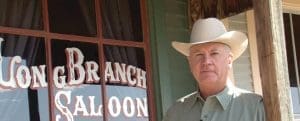
By Jim Whitt Contributing Editor
When I was a young salesman with Purina, Frontier Feed Yard in the Texas Panhandle was part of Paul Engler’s Cactus organization. Bronc May, the manager at Frontier at the time, was one of the true characters of the feedyard industry and I spent a lot of time calling on Bronc. This was so long ago that I can’t remember all the details, but Dr. Ted Jackson, our nutritionist based in Lubbock, and I made several trips to the Cactus headquarters which were then located in Dumas. I can still remember sitting in the room with Paul and a couple of his lieutenants which, as you might imagine, could be quite intimidating. They decided to use Ted as their nutritionist at Frontier on a trial basis. The trial was a success and we got Frontier’s business on a full-time basis. The day that decision was made Bronc presented Ted and me with red satin jackets emblazoned with the Frontier name and logo. That jacket was like the red badge of courage to me.
Everyone in the cattle business knew who Paul Engler was, but he became known to the rest of the world when Oprah Winfrey aired a segment on her show about mad cow disease in 1996 and declared she would never eat another burger. The incident led to fed cattle prices tanking in the aftermath in what was called the “Oprah crash.” Paul became the lead plaintiff in a lawsuit brought against Winfrey to recover damages to cattle feeders. Oprah broadcast her show from Amarillo during the trial and turned it into a public relations coup d’état. The jury voted unanimously in Winfrey’s favor but like a true cattle feeder, Paul didn’t see it as a total loss. Many years later he told the Amarillo Globe-News: “I think we did some good. After that, I think they were more careful about getting good experts and people that had good reputations and so forth that could make statements on an authoritative basis. I think we cleaned up her act.”
In 2002, Richard McDonald, the CEO of Texas Cattle Feeders Association (TCFA), hired me to keynote TCFA’s annual convention. The industry had been bleeding red ink for a few years and feeders were pressuring their trade associations to do something about the usual suspects: the packers, captive supply, imports, etc. That was the mood when I stepped up on the stage to speak.
“I think we did some good. After that, I think they were more careful about getting good experts and people that had good reputations and so forth that could make statements on an authoritative basis.” – Paul Engler
As if I needed more pressure, Paul Engler was the chairman of TCFA that year and he and his wife were sitting on the front row. Talk about intimidation! I felt like I was in one those meetings with Paul in Dumas, except in front of hundreds of people. I had prepared a power point presentation with my take on what TCFA members might do to deal with the miserable state of the industry. Taking my life in my own hands I suggested that we should turn to an industry expert for advice and threw up a slide featuring a wide-eyed Oprah. The audience erupted in laughter. Paul had a shocked expression on his face, but he recovered quickly and then he laughed, too. His wife came up to me afterwards and said she wanted me to know how much Paul enjoyed my presentation. I survived another test with Paul Engler.
Those are my favorite memories of Paul Engler. Volumes of books could be filled with memories from dozens of people whose lives crossed paths with him. My friend Quint Finney went to work washing water tanks at Frontier when he was in high school. He eventually worked his way up to assistant manager at the yard and then managed several operations for the Sparks companies and is now a successful operations consultant. I asked him if there was a memory that stood out to him about Paul Engler. He said that Paul shared this bit of wisdom with him early in his career: “Feed yards are only concrete and steel without the right people working in them and moving them forward.”
Paul Engler invested in people by giving millions of dollars to the University of Nebraska, West Texas A&M University and the Paul F. and Virginia J. Engler Foundation. But his greatest investment was influencing the people he interacted with throughout his life.






